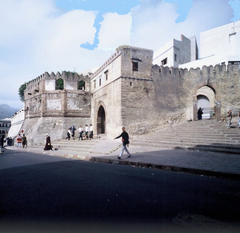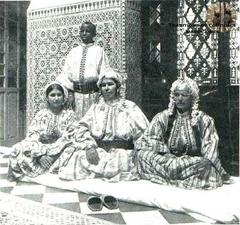
Saniat Rmel Visiting Hours, Tickets, and Travel Guide – Tétouan, Morocco
Date: 04/07/2025
Introduction to Saniat Rmel in Tétouan
Set in the heart of Tétouan, Morocco, Stade Mohamed Abarhoun—still fondly known by locals as Saniat Rmel—is a living testament to the city’s rich cultural tapestry and footballing passion. Established in 1913, this stadium stands as a bridge between the city’s colonial past and its vibrant, modern identity. Originally constructed under the Spanish Protectorate as La Hípica, the stadium has evolved through decades of transformation, bearing witness to the growth of both MA Tétouan football club and the city itself (fr.wikipedia.org, soccerwizdom.com).
Today, Saniat Rmel serves not only as a sports venue but also as a cultural landmark. Its 15,000-seat capacity, combination of covered and open terraces, and central location make it a hub for both locals and visitors. Steps away from the UNESCO-listed Medina, the stadium offers an authentic and accessible experience for those seeking to explore Tétouan’s heritage (stadiumdb.com, mapcarta.com). This guide compiles detailed visitor information, historical insights, and practical tips to help you make the most of your trip to one of Morocco’s most iconic stadiums.
Table of Contents
- Historical Background
- Architectural Features
- Visiting Hours & Ticketing
- Accessibility & Getting There
- Match-Day Experience
- Facilities & Amenities
- Safety & Security
- Practical Visitor Tips
- Nearby Attractions
- Saniat Rmel Airport Guide
- Frequently Asked Questions (FAQ)
- Conclusion
- Sources
Historical Background
Origins and Early Years (1913–1956)
Saniat Rmel traces its roots to 1913, when it was developed as La Hípica during the Spanish Protectorate era (fr.wikipedia.org). Designed to host equestrian and football events, its architecture and function reflected the tastes of the Spanish colonial elite and local notables. The stadium quickly became a cornerstone of Tétouan’s social life, especially after the founding of Moghreb Athletic de Tétouan (MA Tétouan) in 1922.
During this period, MA Tétouan was unique among Moroccan clubs, participating in the Spanish football league system—a legacy that endures in the city’s footballing identity (soccerwizdom.com). Saniat Rmel was the only Moroccan ground to regularly host Spanish league matches, reinforcing its cross-cultural significance.
Post-Independence and Moroccanization
Following Morocco’s independence in 1956, Saniat Rmel transitioned to public ownership and became deeply integrated into the city’s social fabric (stadiumdb.com). The stadium remained the home of MA Tétouan as the club joined the Moroccan league, continuing to draw large crowds and serve as a community hub.
Renovations and Modernization
By the early 2000s, the stadium required significant upgrades. Synthetic turf was installed in 2007, improving year-round playability (fr.wikipedia.org). Further renovations in 2017 focused on modernizing player facilities and expanding capacity. The stadium, now able to accommodate 15,000 spectators, reopened in 2018, cementing its status as a premier football venue (stadiumdb.com).
Commemoration: Stade Mohamed Abarhoun
In 2020, the stadium was renamed after Mohamed Abarhoun, a celebrated local footballer who began his career at MA Tétouan and became a symbol of local pride (fr.wikipedia.org). This renaming underscores the stadium’s role as a site of collective memory and cultural identity.
Saniat Rmel and MA Tétouan
The relationship between the stadium and MA Tétouan is at the core of its cultural significance. The club’s passionate fans, known as “Los Matadores” and the Ultras, bring vibrant energy to matches, making Saniat Rmel an unforgettable destination for football enthusiasts (soccerwizdom.com, stadiumdb.com).
Architectural Features
Design and Structure
Saniat Rmel’s design blends Spanish colonial influences with functional modernism. The oval configuration of the stands provides excellent sightlines, with the main stand offering covered seating and the remainder open to the elements (stadiumdb.com). The pitch is natural grass, maintained to high standards for both domestic and international fixtures.
Cultural Landmark
Adjacent to Tétouan’s historic medina, the stadium is a physical and symbolic bridge between the city’s Andalusian heritage and its contemporary sporting life. On match days, the area comes alive with fans, local vendors, and communal celebrations (wildtrips.net).
Visiting Hours & Ticketing
Visiting Hours
- Match Days: Gates open 1.5–2 hours before kick-off.
- Non-Match Days: Guided tours are available by appointment, typically on weekday mornings and afternoons. Contact the club or visit the official website for details.
Ticket Information
- Purchase Points: Stadium box office (on match days), authorized vendors, or the club’s official website (where available).
- Prices: General admission 30–50 MAD; main stand 70–120 MAD; discounts for children, students, and seniors.
- Tips: For high-profile matches, buy tickets in advance due to high demand (Moghreb de Tétouan Fixtures & Results).
Accessibility & Getting There
Location
Located centrally, Saniat Rmel is about 2 km from the medina and is easily accessed by taxi, bus, or on foot from city-center hotels (mapcarta.com). Public transport is frequent, especially on match days.
Accessibility
The stadium has made efforts to improve accessibility, including some wheelchair-accessible seating and entrances. However, older sections may be challenging; visitors with disabilities are advised to contact the stadium in advance for assistance.
Parking
Parking is limited and fills quickly on match days. Public transport or walking is highly recommended.
Arriving from Out of Town
Tétouan is well-connected by road to Tangier and Chefchaouen, and the nearest airport is Sania Ramel Airport, a few kilometers from the city (Tétouan Travel Guide).
Match-Day Experience
A match at Saniat Rmel is electric. The Ultras’ choreographed displays, the rhythmic singing in Arabic and Spanish, and the festive buzz in surrounding streets create an atmosphere that is both welcoming and exhilarating. Street vendors serve Moroccan snacks, and the community spirit is palpable.
Facilities & Amenities
- Seating: General admission and reserved seating (main stand recommended for comfort).
- Food & Drink: On-site kiosks and street vendors selling local snacks and drinks.
- Merchandise: Official MA Tétouan gear is available at the main entrance.
- Restrooms: Available throughout the stadium, though crowded during major events.
- Accessibility: Some accessible areas; inquire in advance for assistance.
Safety & Security
Security checks are routine at entry points. Arrive early to avoid lines. The stadium is family-friendly, with designated sections for families and children. Keep personal belongings secure and follow staff instructions.
Practical Visitor Tips
- Best Season: The football season runs August–May; Tétouan’s weather is most pleasant from spring to early autumn (Morocco in July: Weather & Travel Tips).
- Clothing: Modest, comfortable clothing; sun protection for day matches.
- Language: Arabic is primary; Spanish and French are widely spoken.
- Photography: Permitted; ask before photographing fans or staff. Professional equipment may require permission.
- Local Etiquette: Embrace the welcoming football culture and respect prayer times and public behavior.
Nearby Attractions
- UNESCO Medina of Tétouan: Renowned for its Andalusian architecture and vibrant souks (wildtrips.net).
- Royal Palace: Viewable from outside.
- Beaches: Martil and Cabo Negro are a short drive away (Tétouan Attractions).
Saniat Rmel Airport: Gateway to Tétouan
Overview
Saniat Rmel Airport is Tétouan’s main air gateway, located about 7 km from the city center. Recent road upgrades have improved access, and parking is available on-site (Medias24).
Operations & Services
- Flights: Domestic and limited international routes. Check with your airline for schedules.
- Transport: Taxis and shuttles to the city center are readily available.
- Facilities: Car rental and luggage storage.
- Accessibility: Ongoing upgrades to improve services for travelers with reduced mobility.
Cultural Significance
The airport plays a crucial role during religious pilgrimage seasons and serves as a first point of contact for visitors and returning residents (Bladi.net). It is being expanded to accommodate up to 2 million passengers annually as part of Morocco’s “Aéroport 2030” strategy.
Frequently Asked Questions (FAQ)
Q: What are the stadium’s visiting hours?
A: Open on match days 1.5–2 hours before kick-off; guided tours by appointment on non-match days.
Q: How do I buy tickets?
A: Buy at the stadium box office, from authorized vendors, or via the club’s website (if available).
Q: Is the stadium accessible for people with disabilities?
A: Some accessible areas; contact the stadium for assistance due to limited access in older sections.
Q: Are guided tours available?
A: Yes, by advance arrangement on weekdays.
Q: How do I get to the stadium from the airport?
A: By taxi or shuttle (about 15 minutes to city center).
Q: Are there nearby attractions?
A: Yes—visit the medina, Royal Palace, museums, and local beaches.
Q: Is the airport open 24/7?
A: The airport operates daily; check with airlines for specific flight times.
Conclusion
Stade Mohamed Abarhoun (Saniat Rmel) is more than just a football stadium—it is a living monument to Tétouan’s enduring spirit and cultural diversity. Whether you come for the thrill of a match, a guided tour, or to soak up the vibrant atmosphere, your visit will offer a unique window into northern Morocco’s sporting and cultural heritage. For the best experience, stay informed via the Audiala app, plan ahead for tickets and transport, and take time to explore the surrounding historical gems.
Sources and Further Reading
- Stade Mohamed Abarhoun (Saniat Rmel) Wikipedia
- MA Tétouan: From Coastal Pride to National Glory, Soccer Wizdom
- Stade Saniat Rmel Details, StadiumDB
- Tétouan City and Attractions Guide, Wild Trips
- Map of Stade Mohamed Abarhoun, Mapcarta
- Bladi.net – Saniat Rmel Airport News
- Medias24 – Airport Expansion
- Moghreb de Tétouan Fixtures & Results, World Football
- Tétouan Travel Guide, Trek Zone
- Morocco in July: Weather & Travel Tips, Kimkim
Image Suggestions:
- Panoramic view of Saniat Rmel during a packed MA Tétouan match (alt: “Stade Mohamed Abarhoun full of spectators during a football match in Tétouan”)
- Historical photo of the stadium, circa 1913 (alt: “Historical image of Saniat Rmel stadium, Tétouan, circa 1913”)
- Map showing Saniat Rmel’s location in Tétouan (alt: “Map showing location of Stade Mohamed Abarhoun in Tétouan city center”)


